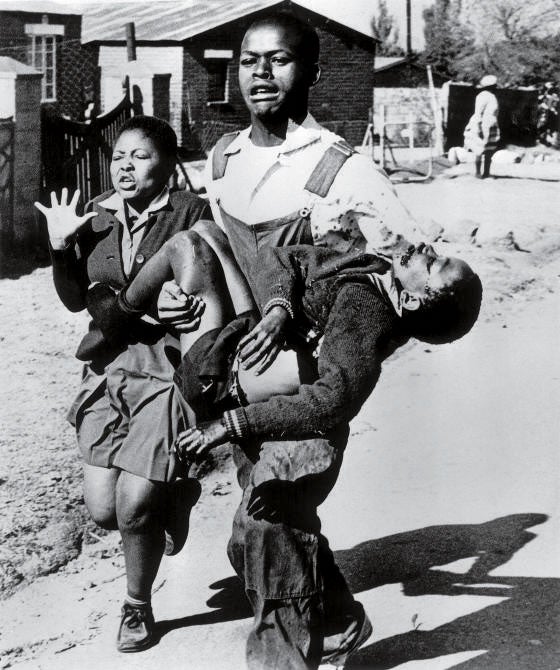
For a child growing up in Soweto, South Africa, in 1976, apartheid was an abstract concept. White minority rule didn’t mean much in a community that was exclusively black. Parents and neighbors complained of denigrating treatment at work and segregated facilities in the nearby city of Johannesburg, but except for the occasional police superintendent or social worker, many children never encountered white people, and rarely experienced the racial divisions of a repugnant social order that treated most of the country’s residents like a lesser form of humanity.
That all changed when the government decreed that instead of learning in English, as most black children were, they would be taught in Afrikaans. To 15-year-old Antoinette Sithole, it was a bombshell. Not only was Afrikaans the language of their colonial oppressors—Afrikaans evolved from the Dutch spoken by South Africa’s first European settlers—she was already having a hard time understanding much of her subject matter. “Obviously physical science on its own is very difficult,” remembers Sithole, now 65. “The very same subject that you are struggling with in English, we are going to do them in Afrikaans? This doesn’t make sense.”
Ali Bomaye! What Muhammad Ali Meant to Me As An African
So Sithole and an estimated 20,000 other students from Soweto’s high schools decided, in secret, to hold a protest. For a young woman caught up in the heady excitement of drafting slogans, writing signboards and practicing revolutionary songs, it was an immense rush. “We were a little bit scared, you know, but we felt free already. It was like, ‘Now we are taking the streets of Soweto with a message.’” The night before the protest, Sithole ironed her school uniform and packed her school bag with placards, while her younger brother, 13-year-old Hector Pieterson, looked on enviously. Younger students were not supposed to be part of the protest.
June 16, 1976 dawned cold and cloudy. As Sithole made her way towards the pre-planned gathering point, she had no idea that the protest would not only change the course of South African history, but that it would also profoundly impact her own life, and that of three other people who are now indelibly linked to the uprising through a singular image that rocked the world.
Though the protest had been planned secretly, one of the organizers leaked details to the media in order to guarantee coverage. Sam Nzima, a 42-year-old photojournalist with The World newspaper, was sent out to cover it. Nzima got his start in photography by taking portraits with a second-hand Brownie camera. When he made it to The World in 1968, there was nowhere else for a black photographer in apartheid-era South Africa to go—even the news was segregated. The World was written by blacks, for blacks. Its sister publication, The Star, was for whites. “Black photographers were not allowed to work for The Star,” says Nzima. “We were only allowed to interview blacks, and we were not allowed to write about whites.” It didn’t even occur to Nzima to protest. “The thing about protesting, you go to jail,” he remembers.
Nzima arrived at Naledi High School around six in the morning. Students were already preparing their placards, scrawling slogans with thick lines of paint: AWAY WITH AFRIKAANS; AFRIKAANS MUST BE ABOLISHED; WE ARE BEING CERTIFIED BUT NOT EDUCATED. Even then, Nzima felt a thick sense of foreboding. Few of the children had any experience with the apartheid state, but he had seen plenty of police crackdowns in his work. They never ended peacefully. “I knew that they would be arrested or be killed. There were no rubber bullets back then. It was live ammunition. When they pull out the gun, you must know that you are dead.”
South African Students Protest Tuition Hikes, Police Respond with Teargas
A few hours later, students were pouring in from across Soweto, waving their placards and singing. Everyone she knew was there, says Sithole. Friends from school, distant acquaintances from church and cousins from miles away. “It was amazing,” she remembers. “It was like we were going on a school trip, but on foot.” Suddenly, she heard a bang, and thick clouds of teargas filled the streets. Police marched down the streets, shouting at the students to disperse. “We all ran amok in confusion, running for cover, dashing into other people’s homes,” remembers Sithole. She didn’t understand why her eyes were burning until someone explained tear gas and gave her water to soothe the pain.
When Sithole crept out of her hiding place, she spotted her younger brother across the street. “He was not supposed to be there. He was too young to understand what was really going on,” she recalls. She waved, and he smiled, too caught up in the excitement to be afraid. Sithole shouted at him to stay put. She kept telling him that they would be ok; that she would find a way to get him home, but inside she was terrified. “I was just saying that because I’m a big sister trying to be brave and bold.”
Several students regrouped, and started singing the banned liberation anthem, “Nkosi Sikelel’iAfrika,”or “Lord Bless Africa.” Nzima stood off to the side, between the students and the police, and watched as an enraged white commander shot his gun directly into the crowd. The students scattered. By the time Sithole returned to the street, her brother was nowhere to be found. “Everybody was just shooting at random,” says Nzima. He rushed in with his camera. “I saw a little boy fall down.”
This article originally appeared on TIME. To read more, visit www.time.com




